Comments / Questions (35)
![]() Christine wrote:
Christine wrote:
Thanks for answering questions. My question is about the gauge. eg. For size medium, we cast on 253 st. With 21 st/10 cm, that should yield 120.5 cm at the bottom of the cardigan. But the diagram says it is 112 cm at the bottom (i.e. 56x2). At the waist, there are 197 st, so 93.8 cm, but the diagram shows 86 cm. Why is the gauge so different from the finished measurements on the diagram? Should I base the size I make on the gauge calculation, or the diagram? Thanks for your help.
13.05.2025 - 04:20DROPS Design answered:
Dear Christine, to count the with we remove the front band stitches: 253-16 front band stitches = 237/2.1 tension= approx 112 /2 (front/back pieces) = 56 cm. Happy knitting!
13.05.2025 - 08:16
![]() Carole wrote:
Carole wrote:
Hello, I have a question about the instructions for decreasing at the top of the sleeve. The pattern says to "cast off for sleeve cap each side at the beginning of every row: 3 stitches I time, 2 stitches 3,4 or 5 times (depending on size). I am a bit confused, do we cast off at the beginning of the row only or at both ends? Also, is it every row, or just the knit rows? Your clarification would be appreciated. Thankyou Carole
16.09.2024 - 01:18DROPS Design answered:
Hi Carole, You cast off 3 stitches at the beginning of the first 2 rows, then 2 stitches at the beginning of the next 6, 8 or 10 rows. So it is every row, always at the beginning of the row and equal numbers of stitches cast off on each side. Happy knitting!
16.09.2024 - 06:48
![]() Birgit Hainzlmayr wrote:
Birgit Hainzlmayr wrote:
Ich bin über die vielen Abnahmen irritiert. Die Jacke hat bei Größe S dann in der Mitte ja nur noch 37 cm Breite. Das kann doch nicht passen, oder? Verstehe ich ds etwas falsch an dem Schnitt?
14.05.2021 - 09:36DROPS Design answered:
Liebe Frau Hainzlmayr, 37 cm ist die Breite vom Rückenteil nachdem alle Abnahmen gestrickt werden , dh wenn 77 Maschen sind für den Rückenteil übrig. Viel Spaß beim stricken!
17.05.2021 - 08:12
![]() Karen Gissell Martinez Guerrero wrote:
Karen Gissell Martinez Guerrero wrote:
Quisiera saber cuál es la puntada y como es, del detalle del frente del suéter... Lo que parece un abanico
04.06.2019 - 07:49DROPS Design answered:
Hola Karen. El cuerpo está trabajado con dos diagramas : M.1 (el detalle pequeño) y M.2 ( el dibujo grande). Ambos se encuentran debajo del patrón.
13.06.2019 - 23:14
![]() Paule wrote:
Paule wrote:
Bonjour, je ne trouve pas les diagrammes pour réaliser ce modèle. Ou se trouve t'il? Merci.
03.05.2018 - 07:40DROPS Design answered:
Bonjour Paule, les diagrammes se trouvent en bas de page. Bon tricot!
03.05.2018 - 07:44
![]() Antonella wrote:
Antonella wrote:
Questo modello mi piace molto, ma purtroppo non riesco proprio ad abituarmi a lavorare con i ferri circolari. C'è un modo per adattare il modello ai ferri dritti? Grazie
09.10.2017 - 13:25DROPS Design answered:
Buongiorno Antonella. Il cardiagan è lavorato avanti e indietro sui ferri. Può quindi sostituire i ferri circolari con quelli dritti e lavorare come indicato nelle spiegazioni. Buon lavoro!
09.10.2017 - 14:18Andrea wrote:
In der R. 14 der Anleitung steht: Nach 32-33-34-35-36-37 cm – die nächste R. wird von der Rückseite gestrickt – nur über die 8 Blendenm hin und zurück stricken, über alle M. stricken und danach auf der anderen Seite nur über die 8 Blendenm hin und zurück stricken (damit der Kragen schön fällt). Danach wieder über alle M. stricken. Soll das nur ein einziges mal gestrickt werden? Herzlichen Dank & viele Grüße
01.05.2017 - 05:31DROPS Design answered:
Lebe Andrea, diese verkürzte Reihen über die 8 Blendem sollen auf beiden Seiten nur einmal gestrickt. Viel Spaß beim stricken!
02.05.2017 - 11:22
![]() Karolien wrote:
Karolien wrote:
Hallo, Ben al begonnen met dit patroon en hij wordt prachtig maar wat doe ik aan die omgekrulde zoom? Ben er bang voor dat hij na het liggend drogen weer omkrult! Alvast bedankt voor het antwoord.
09.03.2016 - 21:23DROPS Design answered:
Hoi Karolien. Meestal wordt de rand recht na de eerste keer wassen/drogen. Maar je kan de rand ook na afloop licht persen met een strijkijzer (leg eventueel een vochtige theedoek ertussen).
10.03.2016 - 13:42
![]() Agnes Con Der Goltz wrote:
Agnes Con Der Goltz wrote:
Hall Zusammen Bei diesem Model sollen nach dem Maschenanschlag sollen 2 Krausrippen gestrickt werden. Diese drehen sich bei mir nach oben. Wie kann ich dies verhindern? Vielen Dank
26.08.2015 - 15:30DROPS Design answered:
Sie können nach dem Stricken die Jacke bzw. den unteren Rand unter ein feuchtes Tuch legen und das Ganze dann trocknen lassen. Oder Sie feuchten den Rand an und stecken die Jacke mit Nadeln auf einer geeigneten Unterlage fest. Damit lässt sich der Rand in Form bringen und man kann einem Umklappen entgegenwirken.
01.09.2015 - 15:46
![]() Simona wrote:
Simona wrote:
Buongiorno. Sono interessata a realizzare questo modello in taglia XS/S ma vorrei maniche lunghe regolari e non a 3/4. Come posso fare? Grazie
22.05.2015 - 14:17DROPS Design answered:
Buongiorno Simona. Per avere maniche più lunghe, è sufficiente che, terminati gli aumenti sulle maniche, lavori per qualche cm in più rispetto a quanto indicato, prima di intrecciare le m per gli scalfi. Può esserle utile confrontare il suo lavoro con la manica di un indumento analogo della lunghezza giusta. Buon lavoro!
22.05.2015 - 14:29
Sea Bird#seabirdcardigan |
||||||||||
 |
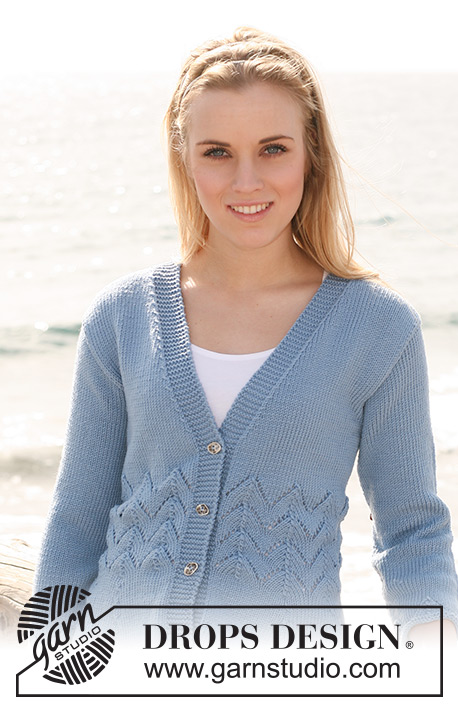 |
|||||||||
Knitted DROPS jacket with darts at the front, lace pattern and ¾ sleeves in ”Merino Extra Fine”. Size XS/S - XXXL.
DROPS 119-34 |
||||||||||
|
PATTERN: See diagram M.1 and M.2. Diagram shows the pattern from RS. First row = RS. GARTER ST (back and forth on needle): K all rows. DECREASING TIP (applies to neck): Make all dec from RS inside front band sts in garter st. Dec as follows after 8 front band sts: slip 1 st as if to K, K1, psso. Dec as follows before 8 front band sts: K2 tog. BUTTONHOLES: Make buttonholes on right front band. 1 buttonhole = cast off 4th front band st from mid front and cast on 1 new st on next row. Make buttonholes when piece measures: SIZE XS/S: 17, 24 and 31 cm. SIZE M: 16, 24 and 32 cm. SIZE L: 17, 25 and 33 cm. SIZE XL: 16, 25 and 34 cm. SIZE XXL: 14, 21, 28 and 35 cm. SIZE XXXL: 13, 21, 28 and 36 cm. -------------------------------------------------------- -------------------------------------------------------- JACKET: BODY PIECE: Worked back and forth on circular needle from mid front. Cast on 229-253-265-289-317-341 sts (includes 8 front band sts each side towards mid front) on circular needle size 4 mm with Merino Extra Fine. Work 4 rows GARTER ST - see above, and continue in stocking st with 8 front band sts each side in garter st. When piece measures 4-4-4-4-3-3 cm work next row as follows from RS: 8 garter sts (= front band), 24-24-24-24-23-23 stocking sts, M.1 (= 3 sts), 23-23-23-35-33-45 stocking sts, M.1, 106-130-142-142-176-176 stocking sts, M.1, 23-23-23-35-33-45 stocking sts, M.1, 25-25-25-25-24-24 stocking sts and 8 garter sts (= front band). Repeat the 4 dec in M.1 (= 8 dec sts) in the same place on every 2 cm a total of 7-7-7-7-6-6 times = 173-197-209-233-269-293 sts – NOTE: For every row with dec there will be 1 less stocking st each side of M.1. After the last row with M.1 work next row as follows from RS (piece measures approx 16-16-16-16-13-13 cm): 8 front band sts in garter st, M.2 on the next 156-180-192-216-252-276 sts, 1 stocking st, 8 front band sts in garter st. REMEMBER BUTTONHOLES ON RIGHT FRONT BAND - see above - NOTE: Make sure st marked with arrow in M.2 sits mid over M.1. Work 4-4-4-4-5-5 vertical repeats of M.2. After M.2 continue in stocking st with front bands in garter st as before. Insert a marker 48-53-56-62-71-77 sts in from each side (= 77-91-97-109-127-139 sts between markers on back piece) – let the markers follow the piece as you go along. When piece measures 32-33-34-35-36-37 cm - adjust so that next row is from WS – work 2 rows garter st on the 8 front band sts only (do not work remaining sts) work 1 row stocking st from WS on all sts, and then work 2 rows garter st on the 8 front band sts only the other side. Now continue on all sts again. AT THE SAME TIME on first row from RS dec 1 st for neck each side towards mid front – see DECREASING TIP! Repeat the dec on every other row a total of 13-8-8-7-7-6 times and then on every 4th row a total of 8-11-12-13-14-15 times. AT THE SAME TIME when piece measures 37-38-39-40-41-42 cm cast off 6 sts each side for armhole (= 3 sts each side of marker) and complete front and back pieces separately. LEFT FRONT PIECE: Continue dec for neck. AT THE SAME TIME cast off for armhole at beg of every row from the side: 3 sts 0-0-0-0-1-1 time, 2 sts 0-1-2-3-5-7 times and 1 st 0-3-3-6-5-4 times. When all dec are complete there are 24-26-26-27-29-32 sts left on needle. Cast off when piece measures 56-58-60-62-64-66 cm. RIGHT FRONT PIECE: Like left front piece, but mirrored. BACK PIECE = 71-85-91-103-121-133 sts. Cast off for armhole each side as described for front piece = 71-75-77-79-85-91 sts. When piece measures 52-54-56-58-60-62 cm work garter st on the middle 37-37-39-39-41-41 sts (remaining sts in stocking st as before). When piece measures 54-56-58-60-62-64 cm cast off the middle 21-21-23-23-25-25 sts for neck and complete each shoulder separately. Continue in stocking st with 8 garter sts towards neckline. AT THE SAME TIME cast off 1 st on neckline on next row – see DECREASING TIP = 24-26-26-27-29-32 sts. Cast off when piece measures 56-58-60-62-64-66 cm. SLEEVE: Worked back and forth on circular needle. LOOSELY cast on 62-62-62-74-74-74 sts on circular needle size 4 mm with Merino Extra Fine. Work 2 rows garter st and continue in M.2 with 1 edge st each side. After 1 vertical repeat of M.2 complete piece in stocking st. AT THE SAME TIME when piece measures 6 cm inc 1 st each side, and repeat the inc on every 6.5-4-3-4-2.5-2 cm a total of 5-7-10-7-10-12 times = 72-76-82-88-94-98 sts. When piece measures 35-34-34-33-31-31 cm - NOTE! Less for the larger sizes because of longer sleeve cap and wider shoulder - cast off for sleeve cap each side at the beg of every row: 3 sts 1 time, 2 sts 3-3-4-4-5-5 times and 1 st 2-2-3-4-5-7 times, then 2 sts each side until piece measures 41-41-42-42-42-43 cm, now cast off 3 sts each side 1 time and cast off remaining sts. Piece measures approx 42-42-43-43-43-44 cm. ASSEMBLY: Sew shoulder seams. Sew sleeve seams inside 1 edge st and set in sleeves. Sew on buttons. |
||||||||||
Diagram explanations |
||||||||||
|
||||||||||
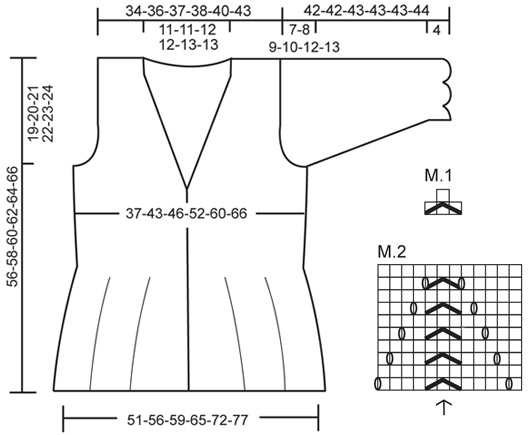
|
||||||||||
Have you finished this pattern?Tag your pictures with #dropspattern #seabirdcardigan or submit them to the #dropsfan gallery. Do you need help with this pattern?You'll find 17 tutorial videos, a Comments/Questions area and more by visiting the pattern on garnstudio.com. © 1982-2025 DROPS Design A/S. We reserve all rights. This document, including all its sub-sections, has copyrights. Read more about what you can do with our patterns at the bottom of each pattern on our site. |
||||||||||







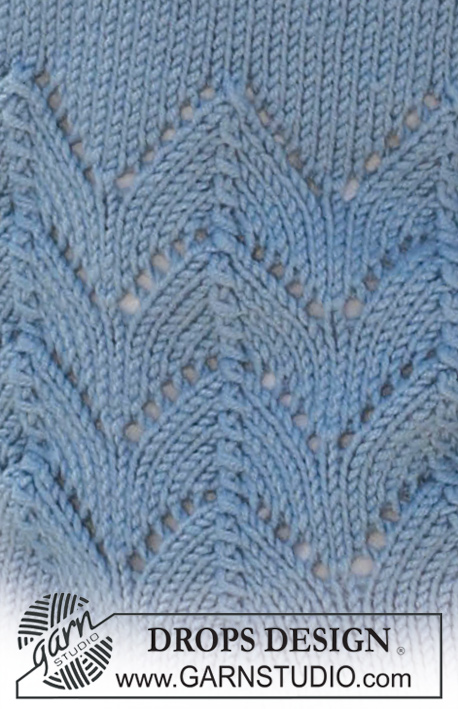

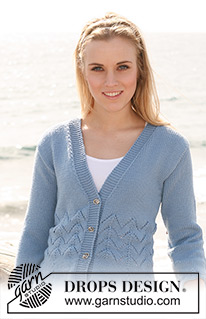



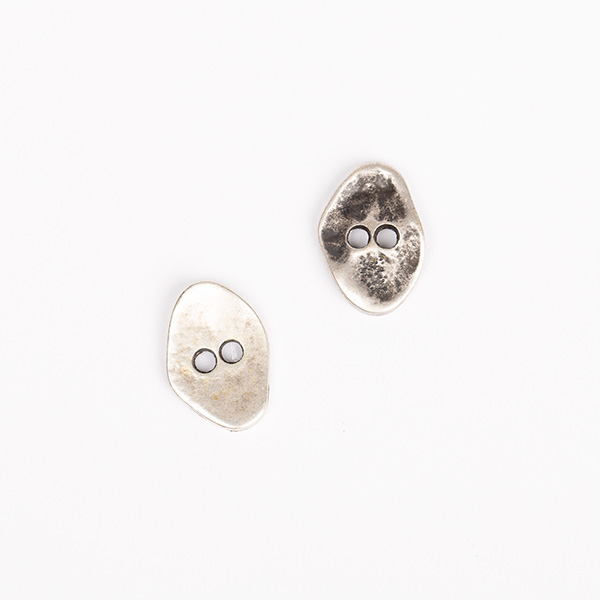

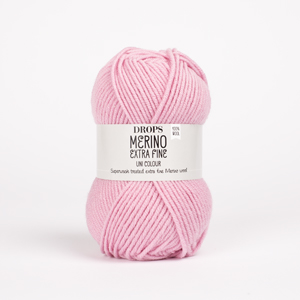
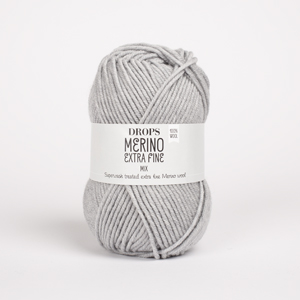










































Post a comment to pattern DROPS 119-34
We would love to hear what you have to say about this pattern!
If you want to leave a question, please make sure you select the correct category in the form below, to speed up the answering process. Required fields are marked *.